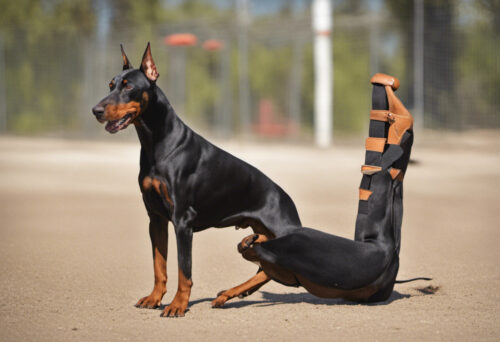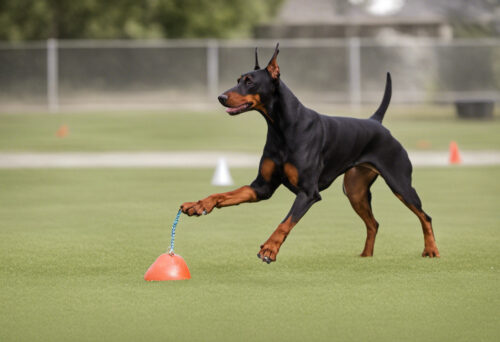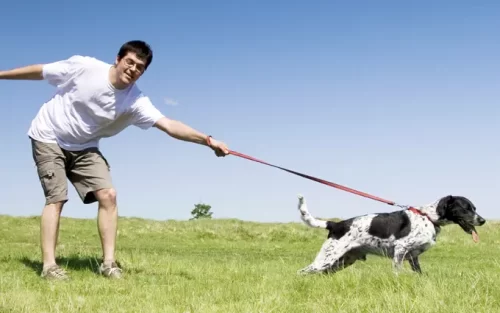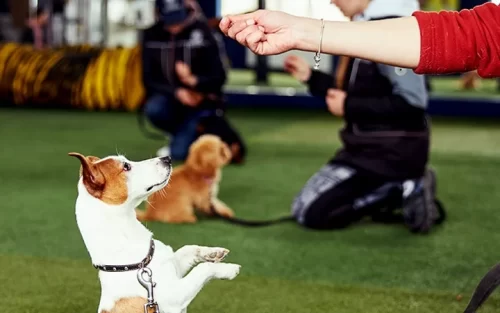Welcome to the exciting world of training your Doberman! Dobermans are known for their keen intellect, unwavering loyalty and majestic appearance. However, harnessing the potential of this powerful breed requires commitment, consistency, and an understanding of the Doberman’s unique temperament and needs. In this guide, we’ll discuss Doberman training tips and techniques that will help you to bond with your Doberman while also developing obedience and discipline.
Understanding Your Doberman’s Temperament
Doberman training begins with an understanding of their unique temperament. Intelligent and highly trainable, these dogs thrive on mental stimulation and physical activity. They also possess a strong desire to please their owners, which can make training both a challenge and a joy. The key to effective Doberman training is to channel their intelligence and energy productively.
Begin Training Early
Doberman puppies should start their training as early as 8 weeks old. During this time, they are very receptive to learning new things and their habits are not yet set in stone. This is the perfect time to establish the basic commands of sit, stay, come, and leave it.
Be Consistent
Consistency is also key when it comes to training Dobermans. This breed is very smart and they will pick up any inconsistencies in your commands or your reinforcement. Make sure you always use the same command for the desired action and follow through with the appropriate reinforcement techniques. Remember, patience and consistency are fundamental components of successful Doberman training.
Specialized Training Techniques
There are several specialized training techniques you can incorporate into your Doberman’s routine. A good place to start is obedience training, but there are also other more specialized dog training techniques you might consider, such as agility training to keep your Doberman physically engaged, or therapy dog training if you want your dog to offer comfort to others.
Obedience Training
When it comes to Doberman training, obedience is particularly important. This is due to their inherent protective instincts and the fact that their large size makes it essential for them to be well-behaved. Movements like sitting, staying, laying down, and coming when called are fundamental commands that every Doberman should master.
Agility Training
Agility training isn’t just a way to have fun with your dog. It also gives him the physical exercise and mental stimulation he needs. Dobermans are very agile and fast learners, making them perfect candidates for agility training. Courses can involve weaving through poles, jumping over hurdles, and scaling walls. Just remember, the key is to make it fun and rewarding!
Remember, Doberman training is as much an art as it is a science. Understanding your Doberman’s needs and temperament, along with adopting effective techniques, will go a long way in making your training journey successful and enjoyable.

Therapy Dog Training
If you have the desire to make a difference in the lives of others, you might consider training your Doberman to be a therapy dog. Due to their calm demeanor and intuitive nature, Dobermans can make excellent therapy dogs. Not only can it bring a great deal of joy and comfort to those in need, but it also provides another level of mental and emotional engagement for your dog.
Positive Reinforcement Techniques
Among the Doberman training techniques, using positive reinforcement is an essential one. Reward-based training enhances the bond between you and your Doberman, while at the same time encouraging good behavior. Whether it’s a pat on the head, kind words or a tasty treat, rewarding your dog immediately after a desired behavior is an effective way to train.
Socializing Your Doberman
Another critical aspect of Doberman training is early and consistent socialization. Start socializing your Doberman as early as possible to introduce him to different people, environments, and other animals. This will not only make your Doberman more well-rounded, but it will also make him more comfortable in various situations and reduce nervous or aggressive behavior.
Building Trust
Building a trusting relationship with your Doberman is pivotal in the training process. Keep in mind, trust is not built overnight; it’s a gradual process that involves treating your dog with kindness, respect, and consistency. Gaining your Doberman’s trust will make him more responsive during training and will help foster a strong and lasting bond.
Understanding Body Language
Your Doberman’s body language is an honest reflection of his state of mind. Relaxed ears, a loose tail, and a ‘smiling’ mouth are indicators of a happy, relaxed dog, while an enigmatic gaze, bared teeth, and a stiffened body indicate a tense, potentially aggressive dog. Understanding these signs can help you identify and rectify issues before they escalate.
Professional Training
Don’t be disheartened if you’re finding it challenging to train your Doberman yourself. It’s all part of the process and sometimes, you might need a little assistance. Don’t worry, professional trainers are always available to help. Websites like The American Kennel Club’s website can connect you with professional trainers in your region.
In conclusion, Doberman training demands diligence, patience, and understanding. Remember, your Doberman is not JUST a pet, he’s a family member, and like any family member, he’ll need love, support, and guidance. Embrace the journey, celebrating each milestone and learning from each challenge. Your hard work and dedication will culminate in a loving, well-behaved, and loyal companion who will stick with you through thick and thin.

Understanding Doberman Body Language and Communication
Training your Doberman is not just about teaching commands – it’s about learning how to communicate with each other. One of the first steps to effective communication is understanding your Doberman’s body language. Dogs express their feelings, intentions, and thoughts primarily through nonverbal cues such as body postures, facial expressions, tail movements, and vocalizations. By understanding these, you can respond appropriately to your dog’s needs, fostering a successful Doberman training.
Crate Training
Another technique you might find helpful in training your Doberman is crate training. When done correctly, a crate can provide your Doberman with a safe space that he will associate with comfort and security. There are many sites, like The Humane Society, that provide comprehensive guides on how to crate train your dog in a relaxed and enjoyable manner.
Clicker Training
Clicker training is a popular positive reinforcement method used in Doberman training. It involves using a clicker, a device that produces a distinct noise, to ‘mark’ desired behaviors. The marked behavior is immediately followed by a reward, such as a treat or toy, which reinforces the behavior. The Karen Pryor Clicker Training website provides detailed instructions on getting started with clicker training.
Professional Help
If you’re finding Doberman training challenging, don’t get discouraged. There are plenty of professional dog trainers who can provide guidance and assistance. Consulting a professional can help you gain valuable insights into your Doberman’s behaviour and personality, paving the way for a successful and harmonious relationship.
Join a Doberman-specific Club
If you want to further immerse yourself and your Doberman in the training process, you might want to consider joining a breed-specific club. Networks like the Doberman Pinscher Club of America offer fantastic resources on Doberman training and provide opportunities for your pet to socialize.
Review: Doberman Training Tips and Techniques
Remember, mastering the art of Doberman training requires perseverance, patience, and plenty of positive reinforcement. Understanding your dog’s unique temperament, early socialization, consistency in commands and their applications, and trust-building are all parts of this rewarding journey. Whether you commence specialized, positive reinforcement or professional training, always keep your dog’s wellbeing and happiness at the heart of the process.
So why wait? Start now and bring out the best in your Doberman!



